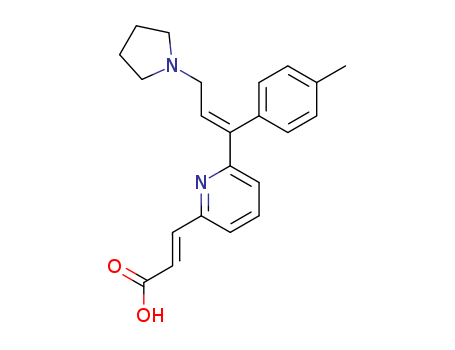Technology Process of Acrivastine
There total 9 articles about Acrivastine which
guide to synthetic route it.
The literature collected by LookChem mainly comes from the sharing of users and the free literature resources found by Internet computing technology. We keep the original model of the professional version of literature to make it easier and faster for users to retrieve and use. At the same time, we analyze and calculate the most feasible synthesis route with the highest yield for your reference as below:
synthetic route:
- Guidance literature:
-
With
silica gel; potassium hydroxide;
In
acetone;
at 35 - 45 ℃;
for 2h;
Reagent/catalyst;
Solvent;
Temperature;
Inert atmosphere;
Green chemistry;
- Guidance literature:
-
Multi-step reaction with 5 steps
1: 12.2 g / BuLi / hexane; diethyl ether / 3 h / -50 °C
2: 24.3 g / p-toluenesulfonic acid / toluene / 6 h / Heating
3: 2.5 g / BuLi / diethyl ether; hexane / 4 h / -50 °C
4: 1.) NaH, 2.) conc. HCl / 1.) DME, 2 h, 2.) ethanol, H2O, steam bath, 10 min
5: 1.) BuLi, 2.) NaOH / 1.) hexane, toluene, 75 deg C, 2 h, 2.) ethanol, steam bath, 10 min
With
hydrogenchloride; sodium hydroxide; n-butyllithium; sodium hydride; toluene-4-sulfonic acid;
In
diethyl ether; hexane; toluene;
DOI:10.1002/jps.2600731003
- Guidance literature:
-
Multi-step reaction with 4 steps
1: 24.3 g / p-toluenesulfonic acid / toluene / 6 h / Heating
2: 2.5 g / BuLi / diethyl ether; hexane / 4 h / -50 °C
3: 1.) NaH, 2.) conc. HCl / 1.) DME, 2 h, 2.) ethanol, H2O, steam bath, 10 min
4: 1.) BuLi, 2.) NaOH / 1.) hexane, toluene, 75 deg C, 2 h, 2.) ethanol, steam bath, 10 min
With
hydrogenchloride; sodium hydroxide; n-butyllithium; sodium hydride; toluene-4-sulfonic acid;
In
diethyl ether; hexane; toluene;
DOI:10.1002/jps.2600731003



 Xn,
Xn, Xi
Xi

